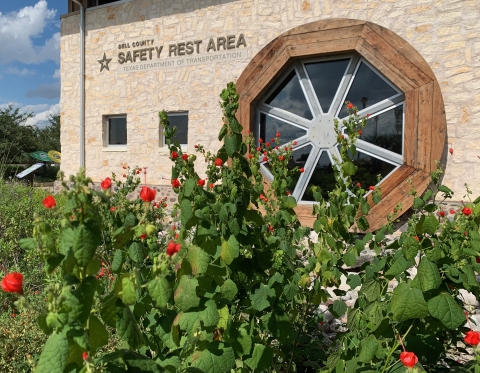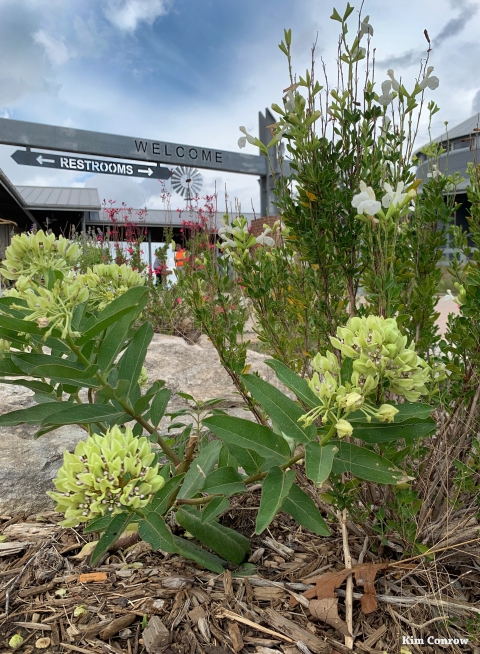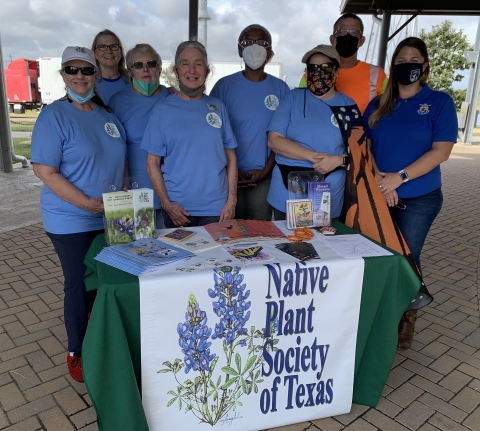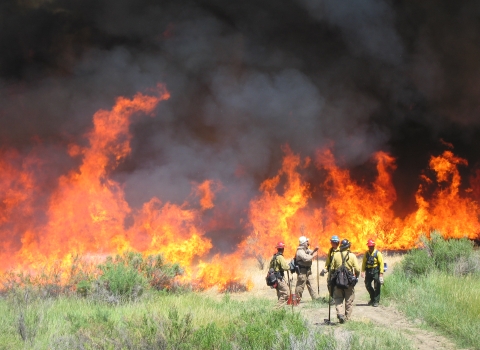Just as people rely on rest areas to refresh and sustain us during long journeys, so do monarchs, which need areas rich with milkweeds and nectar-producing plants to keep them fed during their 2,500-mile migration between Mexico and Canada.
To help meet the needs of both kinds of weary travelers, the Native Plant Society of Texas, in partnership with the Texas Department of Transportation (TxDOT) and the U.S. Fish and Wildlife Service, created four monarch waystations at highway rest areas between Austin and Dallas along Interstate 35, also known as the official “Monarch Highway”. Monarch waystations are patches of habitat that provide resources for monarchs to produce successive generations and sustain their migration.
“Texas is the intersection of the monarch’s migration highways, connecting spring and summer breeding and migration habitat across the United States and Canada with winter habitat in central Mexico,” said Katie Boyer, At-Risk Species Coordinator for the U.S. Fish and Wildlife Service’s Southwest Region. “Monarchs can travel about 50 miles a day when they're migrating, so having these pockets of habitat for them to stop over along that route is really important.”
The monarch waystations feature hundreds of Texas native nectar plants, including critically important milkweeds.
“Native Texas milkweeds provide a vital home for the first generation of monarchs produced each year in the spring, and our fall blooming nectar plants provide much-needed fuel for migrating monarchs en route to Mexico each fall,” Boyer said.
In addition to providing a place for the insects to feed, rest and reproduce, the monarch waystations provide a variety of other benefits for people, too. For drivers and travelers, the waystations encourage good safety practices, like sticking around and enjoying the sight of the flowering plants and colorful pollinators before immediately getting back on the road.
The waystations also include educational signage describing the monarch life cycle, migration pattern and the relationship between monarchs and native plants. One of the hopes is that travelers will be inspired by the beautiful gardens and return home to plant native plants for pollinators.
“These will help to educate millions of people about the Monarch Highway, the plight of the monarch butterflies, their amazing lifecycle and ways that anyone can help through the choice of plants they put in their home landscape,” said Kim Conrow with the Native Plant Society of Texas.
While it may seem like there are still a lot of monarchs out there, monarch butterflies east of the Rocky Mountains used to number in the hundreds of millions. Over the last few decades, the population has declined by approximately 80%.
The decline of monarchs – as well as many other butterfly species, birds, bees, and bats that pollinate plants across North America – is an ominous sign for the health of the continent’s natural systems.
Thousands of native wildlife species are at risk if pollinators continue to disappear, and hundreds of millions of people rely on the crops and habitats that pollinators sustain.
“Through gardening with native plant species and educating the public we are helping to save a species, and in the process, we might even save ourselves,” Conrow said.
Boyer said the primary drivers affecting the health of the migratory population of monarchs are changes in breeding, migratory, and overwintering habitat.
“The best way we can address this stressor is to help protect, restore, and enhance monarch habitat,” Boyer said. “Monarch populations benefit from widespread, ongoing conservation measures from the smallest gardens to large, landscape-scale efforts.”
In addition to providing locations and support for the monarch waystations, TxDOT has also enrolled more than a million acres of land in the historic nationwide Monarch Butterfly Candidate Conservation Agreement (CCAA) for Energy and Transportation Lands.
As part of the agreement, TxDOT will continue their longstanding work to support milkweed growth on thousands of acres of rights-of-way on the highways and interstates they manage.
Though large patches of native, nectar-producing plants are ideal for monarch habitat, anyone can make a difference for the species. Conrow said whether you measure your space in acres or square feet, planting native plants for pollinators can help support the entire food web.
“It's critically important for people to plant native plants,” Conrow said. “Make it three seasons of nectar producing plants and add in several milkweeds - and you have a monarch waystation!”
Other ways to help encourage pollinators in your yard include placing shallow dishes of water in sunny areas or creating a muddy spot to provide a water source; providing bee boxes, undisturbed soil areas, and piles of woody debris for shelter and overwintering habitat; avoiding using insecticides; and using compost instead of commercial fertilizers.
Citizen-scientists of all ages can also help conserve and protect monarchs by participating in the International Monarch Monitoring Blitz. During this annual event, citizen-scientists are encouraged to find pollinators and nectar-producing plants, take photos, and share them with friends on social media. In Texas, citizens can find out how to participate through the Texas Parks and Wildlife Department’s “Texas Pollinator BioBlitz”.
Ultimately, saving the monarch butterfly will not happen without working together and creating collaborative opportunities for conservation. From building monarch waystations, planting home pollinator gardens, and spreading awareness of the monarch’s journey to others, everyone can take action to make a difference for the species.
To learn more about the monarch waystations and ways you can help support them, visit the Native Plant Society of Texas. For more information about the Service’s monarch conservation efforts, visit “Save the Monarch”.









